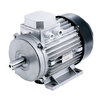A friend of mine has bought this old tool without a motor.
He prefers to recycle the old heavy stuff than buy light diy stuff.
Can anyone identify it to give us a chance of sourcing a 240v 1PH motor?
He has the bottom pully and could fabricate any mounting brackets required.
I notice these tools are usually around 1500w.
Any help appreciated.
Sorry, Images now attached.
He prefers to recycle the old heavy stuff than buy light diy stuff.
Can anyone identify it to give us a chance of sourcing a 240v 1PH motor?
He has the bottom pully and could fabricate any mounting brackets required.
I notice these tools are usually around 1500w.
Any help appreciated.
Sorry, Images now attached.
Attachments
Last edited:






